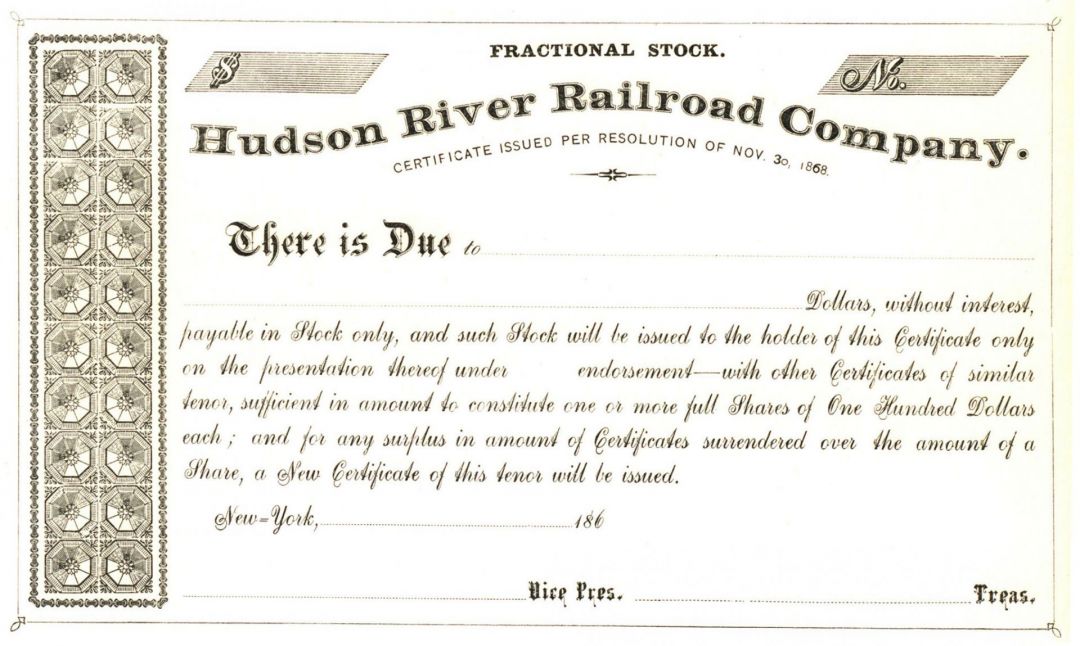Hudson River Railroad Co. - Unissued Fractional Railway Stock Certificate
Inv# RS4068 StockUnissued Fractional Stock. Measures 10 1/4" x 4", Civil War Era.
The Troy and Greenbush Railroad was chartered in 1845 and opened later that year, connecting Troy south to Greenbush (now Rensselaer) on the east side of the Hudson River. The Hudson River Railroad was chartered on May 12, 1846, to extend this line south to New York City; the full line opened on October 3, 1851. Prior to completion, on June 1, it leased the Troy and Greenbush.
Cornelius Vanderbilt obtained control of the Hudson River Railroad in 1864, soon after he bought the parallel New York and Harlem Railroad.
Along the line of the Hudson River Railroad, the West Side Line was built in 1934 in the borough of Manhattan as an elevated bypass of then-abandoned street running trackage on Tenth and Eleventh Avenues. The elevated section has since been abandoned, and the tunnel north of 35th Street is used only by Amtrak trains to New York Penn Station (all other trains use the Spuyten Duyvil and Port Morris Railroad to reach the Harlem Line). The surviving sections of the West Side Line south of 34th Street reopened as the High Line, a linear park built between 2009 and 2014.
In 1867, Cornelius Vanderbilt acquired control of the Albany to Buffalo-running NYC, with the help of maneuverings related to the Hudson River Bridge in Albany. On November 1, 1869, he merged the NYC with his Hudson River Railroad to form the New York Central and Hudson River Railroad. This extended the system south from Albany along the east bank of the Hudson River to New York City, with the leased Troy and Greenbush Railroad running from Albany north to Troy.
Vanderbilt's other lines were operated as part of the NYC; these included the New York and Harlem Railroad, Lake Shore and Michigan Southern Railway, Canada Southern Railway and Michigan Central Railroad.
The Spuyten Duyvil and Port Morris Railroad was chartered in 1869 and opened in 1871, providing a route on the north side of the Harlem River for trains along the Hudson River to head southeast to the New York and Harlem Railroad. Trains could head toward Grand Central Depot, built by NYC and opened in 1871, or to the freight facilities at Port Morris. From opening, it was leased by the NYC.
The Geneva and Lyons Railroad was organized in 1877 and opened in 1878, leased by the NYC from opening. This was a connection between Syracuse and Rochester, running from the main line at Lyons to the Auburn Road at Geneva. It was merged into the NYC in 1890.
In 1885, the New York, West Shore and Buffalo Railway, a competitor since 1883 with trackage along the west shore of the Hudson River and on to Buffalo closely paralleling the NYC, was taken over by the NYC as the West Shore Railroad and developed passenger, freight, and car float operations at Weehawken Terminal. The NYC assumed control of the Pittsburgh and Lake Erie and Boston and Albany Railroads in 1887 and 1900, respectively, with both roads remaining as independently-operating subsidiaries. William H. Newman, president of the New York Central lines, resigned in 1909. Newman had been president since 1901, when he replaced Samuel R. Callaway (who had replaced Depew as president in 1898).
In 1914, the operations of eleven subsidiaries were merged with the New York Central & Hudson River Railroad, re-forming the New York Central Railroad. From the beginning of the merger, the railroad was publicly referred to as the New York Central Lines. In the summer of 1935, the identification was changed to the New York Central System, that name being kept until the merger with the Pennsylvania Railroad in 1968.
The Cleveland, Cincinnati, Chicago and St. Louis Railway, also known as the Big Four, was formed on June 30, 1889, by the merger of the Cleveland, Columbus, Cincinnati and Indianapolis Railway, the Cincinnati, Indianapolis, St. Louis and Chicago Railway and the Indianapolis and St. Louis Railway. The following year, the company gained control of the former Indiana Bloomington and Western Railway. By 1906, the Big Four was itself acquired by the New York Central Railroad. It operated independently until 1930; it was then referred to as the Big Four Route.
A stock certificate is issued by businesses, usually companies. A stock is part of the permanent finance of a business. Normally, they are never repaid, and the investor can recover his/her money only by selling to another investor. Most stocks, or also called shares, earn dividends, at the business's discretion, depending on how well it has traded. A stockholder or shareholder is a part-owner of the business that issued the stock certificates.










Ebay ID: labarre_galleries